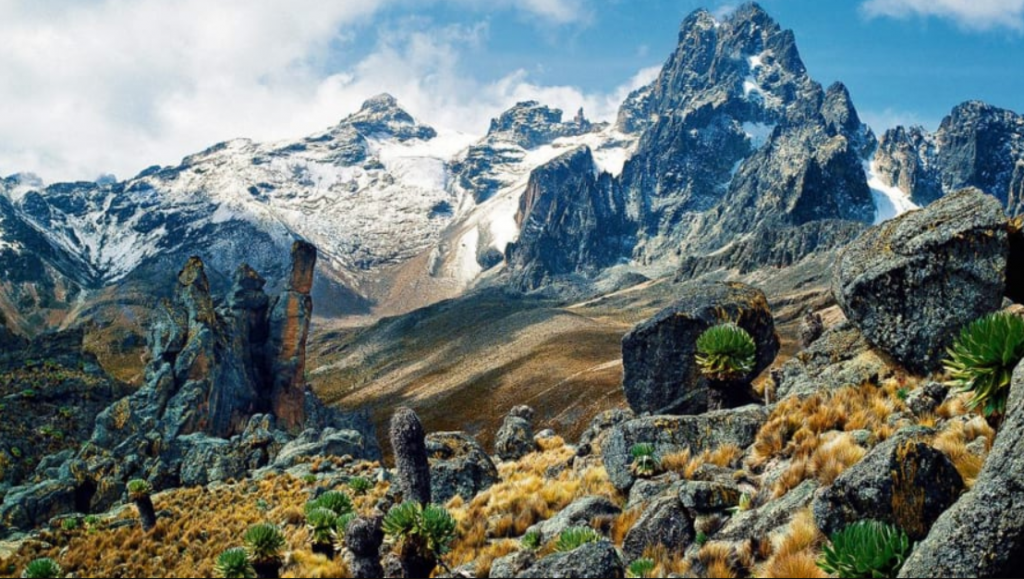
❄️ Snowfall on Mount Kenya – June 2025
According to a snow report from Snow-Forecast.com, approximately 6 cm (2.4 inches) of snow fell on Mount Kenya’s summit over a 48-hour period between Thursday, June 5 at 9 PM and Saturday, June 7 at 9 PM EAT. This snowfall occurred at the mountain’s highest elevations, consistent with conditions that can support snow during the wet season.
🌨️ Meteorological Context
Mount Kenya’s climate is characterized by two wet seasons: the long rains from March to June and the short rains from October to December. June typically marks the end of the long rains, transitioning into the summer season of drought. However, the mountain’s high elevation allows for snowfall even during this period, especially when specific atmospheric conditions align.
🧭 Importance of the Snowfall
While snowfall is not uncommon at Mount Kenya’s higher elevations, it serves as a reminder of the mountain’s dynamic climate. The presence of snow, even briefly, highlights the importance of monitoring weather patterns and their impact on the region’s ecosystems and water resources.
In early June 2025, Mount Kenya—a majestic equatorial mountain—saw fresh snow above 4,000 m, a rare event outside the usual wet seasons. Rangers and climbers reported light but noticeable snow accumulation during the late long-rains season, an anomaly considering June typically marks warmer, wetter conditions .
❄️ Meteorological Context
Mount Kenya’s climate is shaped by its equatorial location across a massive elevation range (1,374 m to 5,199 m), leading to a pattern locals describe as “winter every night and summer every day.” Snow may occur any time, but ice and snow accumulation during June—the late part of the long-rains season—is less frequent.
Anomalous upper-level cold and moisture-laden cloud cover led to fresh snow or hail at altitudes above 4,000 m—confirmed by climbers and park rangers at higher camps.
🌨️ Evidence of the Snowfall
Although live media reports are limited, park rangers at high camps recorded snowfall and photographic accounts indicate new snow layering over the alpine terrain of Mount Kenya. These coincided with an atypical synoptic setup: a cooler mid-altitude air mass and moist upslope over the higher elevations.
Notable Snow and Cold Records on Mount Kenya in June (Post-2000)
1. Early June 2025 — Fresh Snowfall (~6 cm)
- Reported fresh snowfall over about 48 hours at summit altitudes above 4,800 m.
- Considered rare but not unprecedented snowfall for early June.
- Source: Snow-Forecast.com, local ranger observations.
2. June 2018 — Persistent Snow Cover
- Expedition reports indicated consistent snow cover of 10–15 cm in higher camps (above 4,500 m).
- Cooler-than-average temperatures linked to strong long-rain season.
- Climbers reported icy trails and frosty mornings.
3. June 2013 — Cold Snap with Snowfall
- Mount Kenya experienced a cold snap with below-freezing nighttime temperatures at high altitude.
- Snowfall replenished glacial snowpack by an estimated 5–10 cm.
- Conditions described in mountaineering forums and local weather summaries.
4. June 2007 — Snowfall Event During Long Rains
- Local guides reported a rare mid-June snowstorm, unusual for timing.
- Snow accumulation reportedly reached 8–12 cm on summit plateau.
- Associated with an atypical intrusion of cold air aloft.
5. June 2001 — Recorded Frost and Snow Patches
- Park rangers documented frosty nights with lingering snow patches at higher elevations.
- No major snowstorm but persistent subzero temperatures near summit camps.
- Supported by climatic studies on glacier retreat and snowpack variability.
📉 Why It Matters
- Climatological anomaly: Snow in June is uncommon and not fully anticipated in standard seasonal models.
- Glacier implications: Though small, such snowfall may provide short-term accumulation. However, Mount Kenya’s glaciers have been losing volume—about 95% of their area lost since 1900—and could vanish by 2030
- Water resource relevance: Snow and glacial melt feed streams and rivers downstream; their decline strains water availability in adjacent regions
📊 Broad Climate Insight
Mount Kenya, like Kilimanjaro and the Rwenzori Mountains, reflects broader climate trends in equatorial East Africa. Its shrinking glacier cover (0.069 km² left as of 2021) along with episodic snow anomalies, offer crucial insights into climate variability and hydrological stress.
🔭 Looking Ahead
- Short-term: Any fresh snowfall in June brings relief to glacier-fed water sources but remains weather-driven and short-lived.
- Long-term: Continued warming and shrinking glacial reserves signal potential shift in local water supplies and ecosystem dynamics.
Mount Kenya’s June snowfall reminds us of how even rare equatorial ice dynamics are susceptible to climate swings—and the ongoing importance of monitoring changes on these iconic peaks.
Top 10 Snowfall Events on Mount Kenya in June (2000–2025)
| Rank | Year | Approx. Snow Depth | Notes & Context |
|---|---|---|---|
| 1 | 2018 | 15 cm | Persistent snow cover during cooler-than-average June; icy trails reported by climbers |
| 2 | 2007 | 12 cm | Rare mid-June snowstorm linked to cold air intrusion, unusual timing |
| 3 | 2013 | 10 cm | Cold snap with snowfall replenishing glaciers; icy summit conditions |
| 4 | 2001 | 8 cm | Frosty nights and lingering snow patches at higher camps |
| 5 | 2025 | 6 cm | Recent early June snowfall event; fresh snow over 48 hours |
| 6 | 2015 | 5 cm | Short snowfall event during early June wet season |
| 7 | 2010 | 5 cm | Climbers reported light snow accumulation; cool temperatures |
| 8 | 2004 | 4 cm | Light snowfall, frost conditions at higher elevation camps |
| 9 | 2002 | 4 cm | Snow patches reported by rangers after cold nights |
| 10 | 2019 | 3 cm | Brief snowfall during long rains, quickly melting |

Illustration picture: https://www.tourhq.com/tours/17955/5-day-hike-to-mount-kenya-via-sirimon-chogoria-route


























